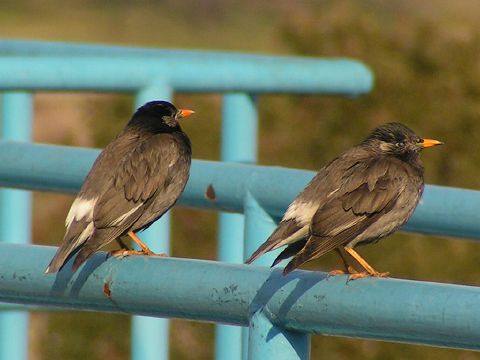- White-cheeked Starling
Taxobox
name = White-cheeked Starling

image_width = 240px
image_caption = Adult male (left) and female
status = LC | status_system = IUCN3.1
regnum =Animal ia
phylum =Chordata
classis =Aves
ordo =Passeriformes
familia =Sturnidae
genus = "Sturnus " (but see text)
species = "S. cineraceus"
binomial = "Sturnus cineraceus"
binomial_authority = Temminck,1835
synonyms =See textThe White-cheeked Starling or Grey Starling ("Sturnus cineraceus") is a
passerine bird of thestarling family. It is native to easternAsia where it is a common and well-known bird in much of its range. Usually, it is placed in the genus "Sturnus ", but sometimes it is united with the typicalmyna s in "Acridotheres ". This is supported by recent studies, but together with theRed-billed Starling ("Sturnus sericeus ") which seems to be its closest living relative it represents an old lineage among the typical mynahs. They might arguably be awarded a distinct genus, but this is probably unnecessary.(Jønsson & Fjeldså 2006, Zuccon et al. 2006)__TOC__Description
White-cheeked Starlings are 24cm in length. The adult male is mainly dark grey-brown with a paler belly and a whitish band across the rump. The head is blackish with whitish cheeks and forehead. There is a white border to the tail and white markings on the secondary wing feathers. The legs are pale orange and the bill is orange with a black tip. Adult females are similar to the males but paler and duller.
The juvenile is brown with pale cheeks and rump and no black tip to the bill.
The loud, monotonous call is a series of harsh, creaking notes.
Distribution and ecology
The breeding range covers central and north-east
China ,Korea ,Japan and south-eastSiberia . In winter birds from colder regions migrate south to southern and eastern China,South Korea , southern Japan,Taiwan and northernVietnam with vagrants reaching thePhilippines ,Thailand andMyanmar . There is a record fromHomer, Alaska in 1998 which probably arrived with a ship (West 2002).It inhabits
woodland , farmland, and open country and has also adapted to parks and gardens in urban areas. It is most common in lowland areas (usually below 700m in Japan).It has a varied diet which includes fruit and
insect s such asmole cricket s.The breeding season lasts from March to July and often two clutches of eggs are laid during that time. The nest is built in a hole in a tree or building or in a
nestbox . Four to nine eggs are laid and are incubated for 14 to 15 days. The young birdsfledge 13 to 15 days after hatching.In popular culture
This is the bird species the
Pokémon Starly ,Staravia , andStaraptor are based on.References
*|year=2004|id=51911|title=Sturnus cineraceus|downloaded=20 July 2007 Database entry includes brief justification for why this species is of least concern
* (1991): "The Birds of Japan". Christopher Helm, London. ISBN 1560980303
* (2006): A phylogenetic supertree of oscine passerine birds (Aves: Passeri). "Zool. Scripta" 35(2): 149–186. doi|:10.1111/j.1463-6409.2006.00221.x (HTML abstract)
* (2000): "A Field Guide to the Birds of China". Oxford University Press. ISBN 0198549407
*(2002): "A guide to the birds of Southeast Asia: Thailand, Peninsular Malaysia, Singapore, Myanmar, Laos, Vietnam, Cambodia". New Holland, London. ISBN 1-85368-313-2
* (2002): "A Birder's Guide to Alaska". American Birding Association. ISBN 1-878788-19-1
*aut|Zuccon, Dario; Cibois, Anne; Pasquet, Eric & Ericson, Per G.P. (2006): Nuclear and mitochondrial sequence data reveal the major lineages of starlings, mynas and related taxa. "Molecular Phylogenetics and Evolution" 41(2): 333-344. doi|10.1016/j.ympev.2006.05.007 (HTML abstract)
Wikimedia Foundation. 2010.
